 Important Important
- In case of replacement, the connecting rods and pistons must always be replaced for all cylinders.
|
|
8.5.1 Connecting rod dimensions check
 Important Important
- Before assembling the connecting rod and pistons (Par. 9.3.7 and 9.3.8), check that the difference in weight between the complete connecting rod and piston units do not exceed 15 gr to prevent weight imbalances during rotation of the crankshaft and consequent damage.
- Mark some references on the connecting rods, caps Q, pistons and gudgeon pins to prevent unintentionally confusing the components during assembly. Failure to do this may result in engine malfunctions.
- Connecting rod half-bearings S must be there with each assembly.
Check that the contact surfaces are perfectly clean and intact.
Assemble the connecting rod cap Q to the connecting rod with the half-bearings S and tighten capscrews P (tightening torque at 28 Nm).
With a dial gauge, measure diameters B and D.
The MAX allowed value of wear for B and D is 0.06 mm.
Tab 8.6
| REF. |
DIMENSIONS (mm) |
CLEARANCE VALUE (mm) |
| A |
192.980 - 193.020 |
|
| B |
37.025 - 37.015 |
0.015 - 0.030 |
| C |
36.995 - 37.000 |
| D |
61.034 - 61.069 |
|
| E |
74.000 - 74.300 |
|
| F |
33.950 - 33.990 |
|
 Important Important
- Tab. 8.6 details the dimensional values of new components only.
- Check that the connecting rod and crankshaft half-bearings are coupled properly.
- Refer to the warnings in Par. 8.4.1 for value D decreased.
- If the clearance value between B and C is not observed, you are required to replace bearing R (Fig. 8.10).
Measure value A, C, D, E and F and confront them with those described in Tab.8.6.
If the measured values do not follow those described in Tab.8.6, replace connecting rod T.
|
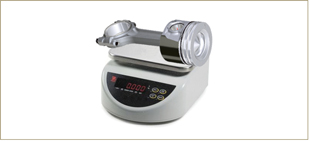
Fig 8.9
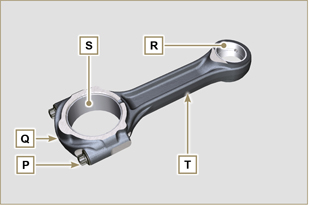
Fig 8.10
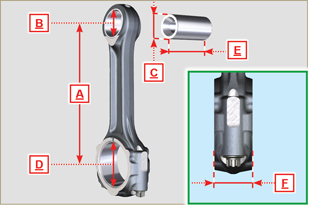
Fig 8.11
|
|
8.5.2 Checking the gudgeon pin-pin axes are parallel
Lubricate gudgeon pin A and bearing R (Fig. 8.10).
Insert the gudgeon pin into bearing R.
Use a dial gauge to check the axis parallelism of the connecting rod big end and small end.
Parallel deviation (value V) measured at the tip of the gudgeonpin, must be a MIN of 0,015 and MAX of 0,030 mm.
If the parallelism values do not comply with the specified ones,replace the connecting rod with a new one.
8.5.3 Piston rings check
Insert ring U into the cylinder, measure value H (distance between the points of ring U).
Repeat for all the seal rings.
If the measured value H does not correspond to the values indicated in the table (Tab. 8.7), replace the seal rings U.
 Important Important
- Seal rings cannot be replaced separately.
NOTE: refer to Fig. 8.17 to locate the rings.
Tab. 8.7
| RINGS |
H (mm) |
| U1 |
0.30 - 0.15 |
| U2 |
0.50 - 0.70 |
| U3 |
0.20 - 0.40 |
|
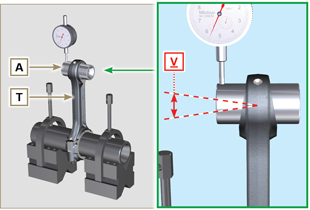
Fig 8.12
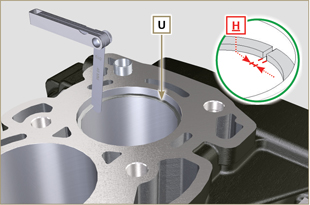
Fig 8.13 |
|
8.5.4 Piston dimension check
Clean the piston thoroughly.
Measure the diameter of the piston at 12 mm (L) from the base of the skirt in correspondence with the graphite lubrication windows M.
Refer to Tab. 8.8 to establish the clearance value of the pistons with a decreased diameter.
In correspondence with point W, there are:
3 digits for the STD piston;
3 digits followed by R for a piston with an increased diameter of 0.20 mm;
+0.5 for a piston with an increased diameter of 0.50 mm;
+1 for a piston with an increased diameter of 1.00 mm;
If clearance between cylinder and piston is greater than 0,074 mm, the piston and seal rings must be replaced.
 Important Important
- Tab. 8.8 details the dimensional values of new components only.
Tab. 8.8
| PISTON |
Ø CYLINDERS
(± 0.007 mm)
|
Ø PISTON
(± 0.007 mm) |
CLEARANCE VALUE
(mm)
|
| STD |
96.010 |
95.950 |
0.046 + 0.074
|
| +0.20 |
96.210 |
96.150 |
| +0.50 |
96.510 |
96.450 |
| +1.00 |
97.010 |
96.950 |
|
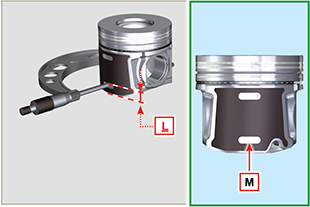
Fig 8.14
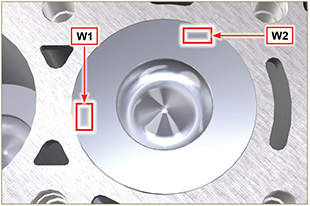
Fig 8.15 |
 Important Important
- With a feeler gauge, measure the clearance of the seal ring in the respective seat (value L1, L2 e L3).
- If the clearance does not comply with the values shown in the Tab. 8.9, replace the seal rings and the piston.
Tab 8.9
| SEAL RINGS |
CLEARANCE VALUE (mm) |
| U1 (L1) |
0.070 - 0.110 |
| U2 (L2) |
0.070 - 1.115 |
| U3 (L3) |
0.030 - 0.070 |
|
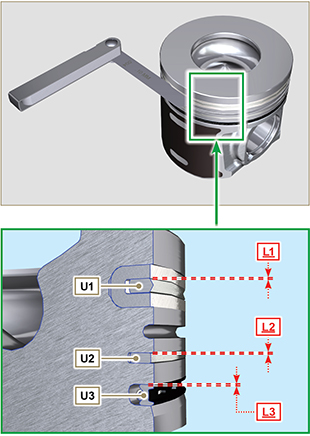
Fig 8.16 / 8.17 |

 Important
Important Important
Important Important
Important


 Important
Important

 Important
Important

 Important
Important



 Loading
Loading